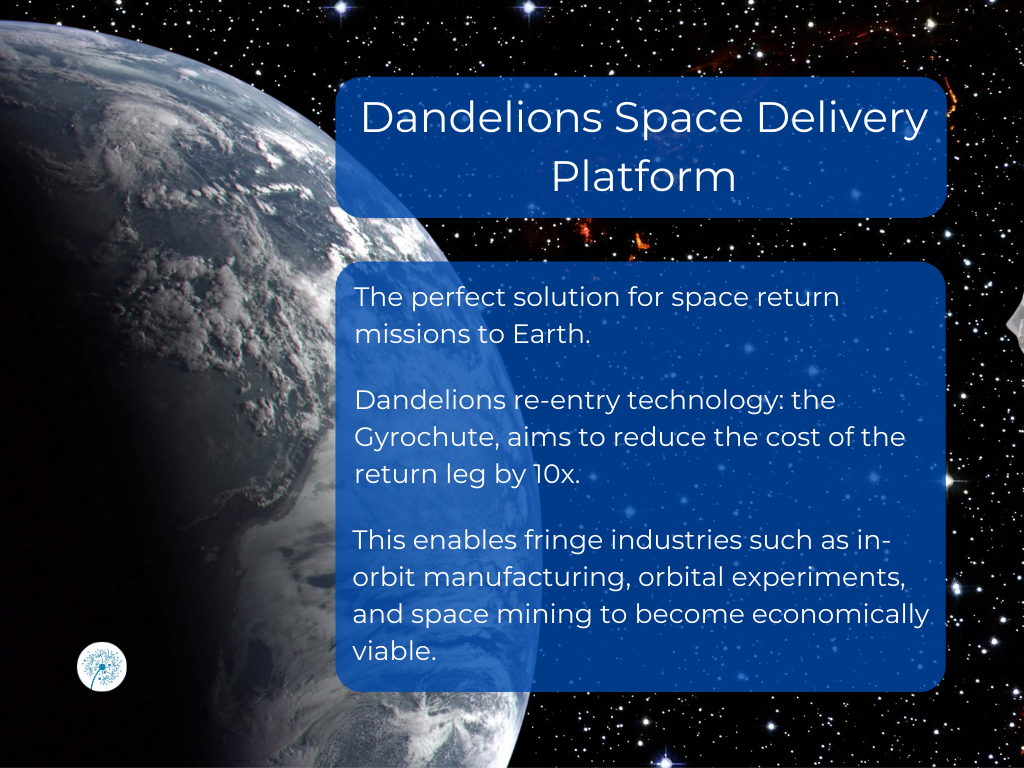Dandelions space delivery capability is provided by the patent pending technology: the Gyrochute. Currently, returning one kilogram from orbit is between $300k to $600k USD according to the NASA Office of Inspector General 2019 Report (1). The aim is to use this highly scalable and cost effective vehicle to reduce the cost of the return leg by 10x. The effect is an overall mission cost (up and down) of $100k USD compared to an average of $550k USD.
The Gyrochute is designed for safe descent of light payloads, specifically communication packages, and this translates to less extreme re-entry conditions compared to bespoke multi-tonne missions. As a consequence, the Gyrochute can act as a versatile and mass-manufacturable re-entry vehicle for return missions. Engineered using advanced manufacturing techniques such as additive manufacturing, and laminate composite lay-up.
This technology expands the return mission market, specifically for sub-500 kilogram payloads, as there are currently only five return vehicle providers, all of which are national agencies or government contractors. By providing a dedicated commercial service, the potential for more in-orbit manufacturing, orbital experiments, and space mining use cases skyrockets. Similarly, global deployment of IoT networks is now accessible; allowing large scale environmental monitoring and rapid telecommunication restoration for disaster affected areas.
In-Orbit Manufacturing
The microgravity environment of low earth orbit makes manufacturing certain products more reliable. These products usually involve a mixing process that is more uniform in space. Such products include, fibre optic cables, metal alloys, and synthetic organs (2). The Gyrochute will enable the growth of this sector with less expensive return missions.
Orbital Experiments
The ISS has been the international base of orbital operations since 2000, and has been continually performing experiments for both commercial and government partners. Notable experiments for commercial partners include the Procter & Gamble colloid study for improving shampoo and fabric softener, as well as a LambdaVision sponsored study to explore manufacturing processes of retinal implants (3). This is only the start of the orbital economy, and it will need a dedicated commercial delivery service to accommodate it.
Space Mining
NASA’s goal of landing on the moon again in 2024 with the Artemis program, coincides with the growth of space mining interest. The moon like any spatial body has resources valuable to Earth prospects. The abundant hydrogen, oxygen and assorted metals are bound up in moon rock, ready to be extracted by future missions to the moon. NASA’s gateway which is aimed to launch in 2024, and will act as a hub for the lunar transportation network. To profitably transport lunar resources, the Gyrochute as a space delivery platform will be required for Earth re-entry.
Summary
The Gyrochute is a scalable, cost effective re-entry vehicle for delivery of a multitude of payloads from low Earth orbit. This technology aims to reduce the return leg cost of every mission by 10x, which in turn enables the exponential growth of fringe industries.
